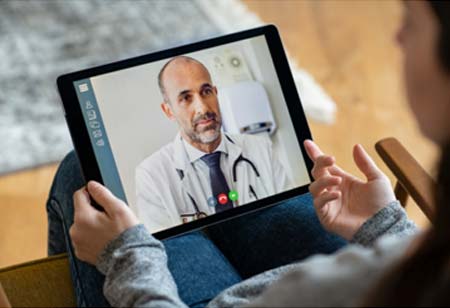Thank you for Subscribing to Healthcare Business Review Weekly Brief

Do No Harm
Healthcare Business Review
Increased use of technology and information technology during the initial stages of COVID was a necessity and a silver lining to the pandemic. Our organization, Houston Methodist, was already out of the starting gate with many innovative technologies when the pandemic hit. We were able to quickly leverage these, and several new technologies, to improve the safety of our patients and staff. (Figure 1) These technologies also brought new efficiencies and convenience into many of our processes. Like the implementation of all new technology, there was a learning curve. We continue to reassess and expand the use of technology to improve communication, interaction with patients, delivery of care, and increase the value of our services.
When designing and implementing new technology, it’s often necessary to thread the needle. The goal should be to improve processes and demonstrate value with intuitive user interfaces that meet back-end business needs. This can be difficult due to the complexity of processes and the variability of customer preferences and capabilities. In healthcare, these variables are often compounded, and the stakes are higher.
We were able to develop and offer a lab test for COVID-19 early in the pandemic. Since our physician offices were closed for safety, we established numerous COVID collection stations across the region. Based on volume and staffing, traditional scheduling wasn’t an option—there wasn’t a process for centralized scheduling of laboratory visits. Working with Blockit Now (https://www.blockitnow.com/) and Epic, our EMR, we were able to generate an automated process to perform most of the scheduling and registrationtasks. When a physician placed a COVID order in the EMR, Blockit texted the patient with a link to an on-line scheduling platform. The Blockit program was linked to the Epic scheduling module. Patients were able to select the location and appointment time based on their preference. The appointments were booked in Epic, and a registration was created.
Staff still had to link the orders to the appointment in the EMR and ensure registration data was complete and accurate, but the front-end process was automated and provided a significant convenience to our patients. In addition, this process kicked off text messaging to the patient confirming the appointment, providing directions and any other special instructions. Many of our sites were drive up or triaged in the parking lot before collection. Messaging allowed us to direct patients to a particular location or spot.
Once patients were inside our facilities, we were very cognizant of social distancing and any clustering in our waiting rooms. Although this was addressed through appropriate scheduling, we further leveraged PatientTrak (https://www.patienttrak.net/) to help with this issue.
This program allowed us to closely monitor patient flow and text-message patients at each step in the process. PatientTrak helped maintain a smooth, safe, and efficient workflow.
We still use these technologies and are looking at expanding their use for routine laboratory testing. However, we need to ensure that we are meeting patient needs and expectations. Houston Methodist is very patient-centric and cannot lose sight of our ICARE values (Figure 2) by over-relying on technology. Patients still want, and need in some cases, personalized communication, individual help, and a hands-on approach. We reinforce this through appropriate text messaging and follow-up during live interactions.
All of us should learn what it looks like from the other side. As consumers, we have these interactions thrust upon us at every turn. When was the last time you called your cable provider? Was the interaction satisfactory? Mine wasn’t. An active Patient Experience program and listening to feedback can help tailor technologies to facilitate transactions, increase efficiency and improve customer loyalty. I recently experienced a somewhat wayward use of technology from a health care company we can all identify with. CVS has a customer loyalty program which seeks to add value by presenting a customized reward system for its members. You may have experienced this with one of the ticker-tape receipts which print in store when you use your Customer Rewards Card. CVS was attempting to personalize the customer experience by providing coupons based on previous purchases. The resulting customized receipts have gotten so out of control that there is an entire movement created to stop them. A quick internet search will provide you with multiple humorousexamples of a good idea gone bad.
Taking it a step further, CVS also wants to make sure you get your prescriptions on time. They have automated programs to remind you when your refills are ready. The messages keep coming until you pick up your prescription or opt out of the program all together. The persistent nature of these text messages and voice mails have also created backlash from their customers. As a response, CVS has published readily available instructions to easilyopt out of their refill notification program.
Good intentions, taken too far, can alienate your customers or patients. We need to balance personalization with usability. Our non-human interactions with our patients need to be easy to use, transparent, and helpful. In communicating, we need to understand the difference between not enough and too much--which can lead to alert fatigue or outright dissatisfaction. There is a difference between helpful and harassment.









